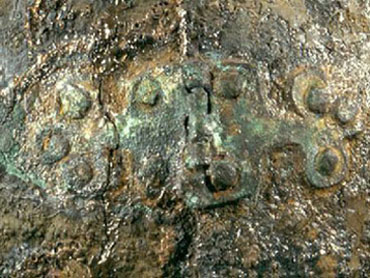
Lobate hinge that joins the central and frontal plates of the upper shoulder guard.
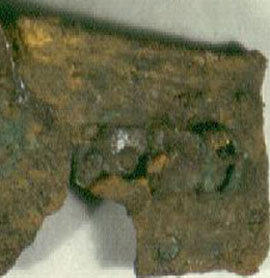
Lateral fastening: a hinged buckle still retaining its tongue. The free-moving ‘center’ link only has one rivet.
Preface:
According to the explanation under “Where did the SCA come from?“ on the “Overview and description of the SCA” page of the SCA website, ‘The SCA "period" is defined to be Western civilization before 1600 AD, concentrating on the Western European High Middle Ages.’ With this text in mind, the following A&S work is submitted with the understanding it while it may fall outside the generally accepted 500 – 1600 A.D. time frame commonly considered within the society to be the Middle Ages; it is within the letter of the SCA law, it therefore technically period.
It is not my intent to debate the rights of SCA player to have and or use Roman personas. I only wish to submit this entry for what it is; a Society for Creative Anachronisms arts and sciences project in armoring. Thank you for your consideration for my work, and my apologies if my statements have offended.
YIS,
Wolfram
Lorica is Latin for "armor" and segmentata is the modern term applied to the cuirass of iron bands or hoops that form this style of Roman armor. It is arguably the most distinctive form of Roman armor ever. Around the time of Emperor Tiberius (A.D.14-37), Lorica Segmentata began to replace the older Lorica Hamata (mail cuirass) in many Legionary formations. This “new” armor was generally considered to be superior to the Lorica Hamata, because of its greater flexibility, lighter weight and it’s comparative ease to manufacture. Other than its introduction in the first Century B.C., we know virtually nothing about Lorica Segmentata’s origins. There are four known main types of Lorica Segmentata, each named after the locations of it’s discovery.
The Kalkriese Lorica, discovered in Kalkriese, Germany (Teutoberger Wald) and dating to 9 A.D.. It is the oldest segmented armor used by the Romans that we currently know of. There is no current reproduction of this armor type.
The Cobridge Type A Lorica, discovered at Cobridge and Chichester, United Kingdom respectively. Along with the Type B, this is the most common type of Lorica Segmentata, and appeared to be most widely issued by the time of Emperor Claudius's invasion of Britannia in 43 A.D.. These two types are the most identifiable lorica and the only style we can reproduce with complete accuracy. This makes them the favored style among re-enactors.
The Cobridge Type B Lorica, discovered at Chichester, United Kingdom. (See Cobridge Type a Lorica.)
The Newstead Lorica, discovered at Trimontium (Newstead), which came into use around 100 A.D..
The Corbridge Hoard, Corbridge, Northumberland, produced fragments of between three and twelve cuirasses. They consisted of upper and lower half assemblies dating between 122 and 138 AD. This style of cuirass was divided into three main types by H. Russell Robinson; types A, B, and C, though B and C only differ with minor details.
Below are several photographic images I used to create my Lorica Segmentata. Each is a fragment from the Corbridge Hoard, and shows a specific are or detail recreated on my armor.
 Lobate hinge that joins the central and frontal plates of the upper shoulder guard. |
 Lateral fastening: a hinged buckle still retaining its tongue. The free-moving ‘center’ link only has one rivet. |
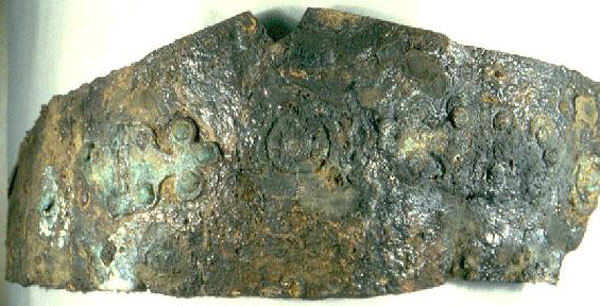
Upper shoulder guard assembly connected via two, tri-lobed hinges.
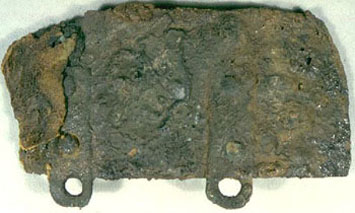 Type C, bottom backplate. The iron vertical fasteners extend below the backplate’s lower edge. |
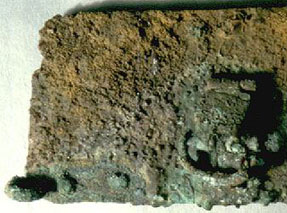 Upper girth plate / band of this cuirass has its undistorted tie loop. |
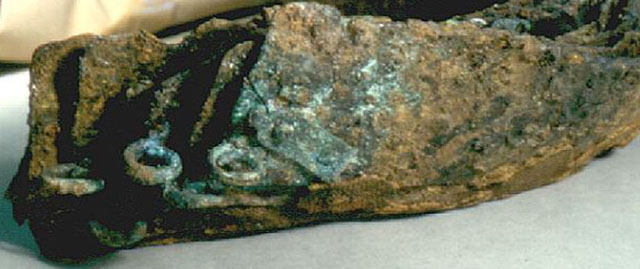
Girth hoops with a vertical fastening hook (swiveled out of its vertical orientation) and lateral tie loops.
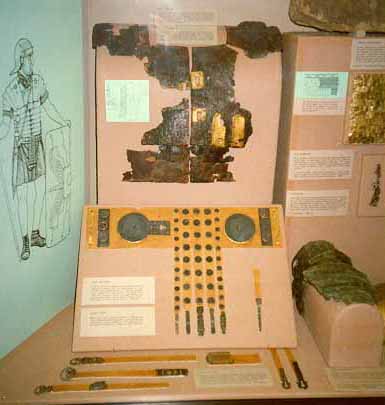
Surviving fragments of the Newstead Scotland lorica (Photo: Tom Kolb).
The "Newstead" Lorica was adopted toward the end of the first-century A.D.. It had a fewer number of larger plates making it less flexible and more uncomfortable to wear. At first it was thought that this style of lorica omitted the three piece hinged structure on the shoulder guard; recent studies have indicate the contrary. This style did occasionally have hinged shoulder assemblies. The hinges were simply larger and wider to increase their strength and make them less prone to breakage. A definitive trait for this style of lorica is lower tie loops mounted similar to paper clips. The loop ends are inserted through slots in the ends of the girth hoops then bent outwards against their backsides. It is believed the "Newstead" Lorica became the dominant style because of its simpler design and lower cost to produce. This is not to say the previous styles were not still in use, only that they were less common. The "Newstead" lorica was to be the final form of "laminated" armor for the Roman Army. It fell out of favor during the 3rd century AD, when the Legions returned to the use of Lorica Hamata (“ring” armor).
Although the find from Newstead provided much information about this fourth type of lorica, it was not as complete as the examples from Corbridge. The fact that it used large lobate hinges was only recognized comparatively recently, largely thanks to further finds from Carlisle. The system of fastening the girth hoops had changed and the upper and lower sections were joined with hooks rather than straps, a technique that first appeared on the Corbridge type. A set of girth hoops from Stillfried (AUT) showed how copper alloy binding was used on the lower and sometimes the upper girth hoops, and a curious hook was set on either side. The main period of use of the Newstead type was c.A.D.140-250.
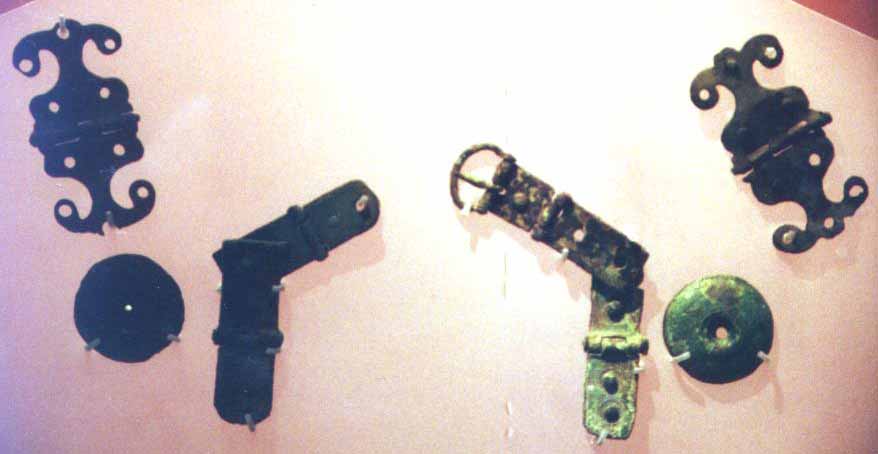
Original Lorica Segmentata fittings; British Museum (Photo: Richard Campbell)
The buckles are complex, dual bend hinges. This designates they were not from the Kalkriese find which is know to use simple leather hinges.
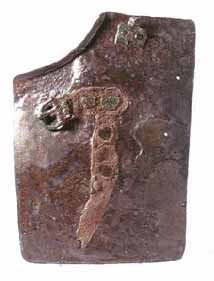
A Breastplate from Kalkriese (Inv.-Nr.: KMO B 94:74, FNr.: 17330) Note the simple fastening method used.
The fastener on the left appears to be two, strap holding hinges joined by a common rivet. This strongly implies both the vertical and lateral fastening was done with leather. This would rule out Type B as it’s vertical fasteners were of the hook and eye variety.
The bright green patina shows us a high level of copper content. One of the traits of Corbridge Type C lorica is they often used iron fittings, which would in turn rule it out.
The lobate hinges are rather small and narrow (roughly twice as wide as the vertical and lateral fittings) where as the Newstead finds were recently recognized as having larger hinges.
General Fabrication:
Because I intended to use this armor for heavy weapons combat, I chose to deviate on some lesser important points during fabrication. The most visual of these differences is the lack of the ornamental disks on the shoulder bands and chest plates. This was done because of my second deviation of using stainless steel on all visible areas, including hinges and fittings, for strength and maintenance purposes. I do not have the tools needed to create the detail of the reinforcing disks in stainless steel so they match the other fittings. I have created some cast in pewter, but after a few test hits from our combat swords severely deformed them.
A less noticeable variant is the gage of metal I used in the suit. Again because of the potential use in SCA combat, I used a base of 16-gage rather then the 18-gage thickness thought to have been used in period. I also increased the gage of the chest (collar) area to 14 for piece of mind. These changes have added significant weight to the lorica and unfortunately have made it prohibitive for combat use. Now I know better.
The tools I used are as follows:
S3 Beverly shear
B2 Beverly shear
#16 Roper-Whitney bench punch
Various hammers
Various chisels
Various files
Custom (self) made fixture to close the lacing loops
1/4" steel rod (to finish the loops around)
A hatchet stake
A 3/16” Rivet seat
A wood log (as one of my anvils)
A “table stake” (flat piece of steel supported by a post in it’s center)
Various diameter steel pipes (as forming tools)
A hand drill
A 1x30” belt sander (for edge finishing)
There are several points of interest that I have discovered during the fabrication and test fitting of this Lorica Segmentata. Below are the points I feel would most benefit first Lorica Segmentata makers.
Your shoulders are not level; they slant down and away from your neck. Be sure to mount your vertical fastening hooks to allow for this sloping. The Lorica Segmentata before you tries to ride square on my shoulders and therefore places almost its entire upper assembly load on my Trapezius muscles (those running from your neck down over your shoulder blade region). I can drill out the bottom rivet of the vertical fittings on my chest plates, and rotate them 5° towards the armholes to resolve this issue. As I was not sure how well this would turn out aesthetically, I decided to wait until after the In a Phoenix Eye competition to make this correction.
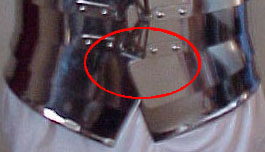
Stainless steel construction is the best way to minimize future maintenance. The extra effort up front is well worth being able to wash your mail in the sink with dish soap! Forming the rings takes about three times as long, but you never have to worry about rust or WD-40 saturated clothing, being poisoned, smelling of oxidation or chemicals or how to best to clean your armor after every use. Your mail will also take more abuse and retain it’s rings better the mild steel construction.
I ventured a theory that a single row of rivets down the cuirass (girdle region) would offer more flexibility during combat. This is not the case. Stay with the wider strapping and use two rivets per girth plate, per location as they did in period. The only thing minimizing the number of rivets in this area did was allow the lower two bands to flare further over my hips. This increased the comfort ability but unfortunately also caused the second lowest girth plates corner’s to drop out from under the bands above exposing my belly button area. (See red oval above.) This issue is a correctable one, but it would have been much easier to avoid the problem in the first place.
Part of the original design-intent of this armor is to absorb contact momentum and spread it around the body rather them into it as is true with most armors. As an Engineer in modern life, it is my belief that the Romans chose a thin gage iron for the girth plates intending them to bend and even dent to absorb potentially damaging forces. I definitely would not have increased the gage of the metal used during fabrication if I had this project to do over again. Lorica Segmentata are very easy to repair and the extra protection is not worth the added weight.
Sources:
A Glossary of the Construction Decoration and Use of Arms and Armor in All Countries and in All Times Together with Some Closely Related Subjects by George Cameron Stone.
Arms and Armor in Antiquity and the Middle Ages by Charles Boutell (1996).
European Arms & Armor by Charles Ashdown.
The Newstead Research Project1 Directed by Dr. Rick Jones, Department of Archaeological Sciences, University of Bradford, UK.
The Armour of Imperial Rome by H. Russell Robinson.
Excavations at Roman Corbridge - The Hoard by Allason-Jones, L., & Bishop, M.C.
Actual photographic images of the Corbridge finds - Armamentarium:
1The Newstead Research Project (NRP) is an archaeological group investigating the region surrounding the Roman complex of Trimontium near Newstead. Trimontium was one of the most important Roman centers on the northern frontier in Britain. It was occupied from the late first century AD through the second. Its extensive excavation in the early 1900’s produced an outstanding amount of Roman artifacts, most all of which now reside in the National Museums of Scotland in Edinburgh.
The NRP has completed ten separate excavations, and the geophysical survey of more than 40 sites in the core survey area, normally by both magnetometry and resistivity surveys. The results of excavation and survey have been combined to result in a greater understanding of the archaeology of the region. They are a highly recommended resource for first hand information!
Copyright Terms, Copyright Wolfram von Taus © 2002, 2003, 2004